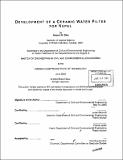| dc.contributor.advisor | Susan Murcott and Patrick Jaillet. | en_US |
| dc.contributor.author | Dies, Robert W. (Robert William), 1976- | en_US |
| dc.contributor.other | Massachusetts Institute of Technology. Dept. of Civil and Environmental Engineering. | en_US |
| dc.coverage.spatial | a-np--- | en_US |
| dc.date.accessioned | 2006-03-24T16:01:39Z | |
| dc.date.available | 2006-03-24T16:01:39Z | |
| dc.date.copyright | 2003 | en_US |
| dc.date.issued | 2003 | en_US |
| dc.identifier.uri | http://hdl.handle.net/1721.1/29553 | |
| dc.description | Thesis (M.Eng.)--Massachusetts Institute of Technology, Dept. of Civil and Environmental Engineering, 2003. | en_US |
| dc.description | Includes bibliographical references (p. 166-170). | en_US |
| dc.description.abstract | Countries like Nepal face tough challenges in terms of providing safe, clean drinking water for their citizens. The World Health Organization estimates that nearly 5 million people in Nepal lack access to safe drinking water while globally, 1.1 billion lack access to improved water supplies. Point-of-use water treatment technologies, such as household ceramic water filters, offer an affordable and effective means of treating water to standards suitable for drinking. The fact that ceramic water filters can be manufactured and produced by local ceramists with local materials makes ceramic filters particularly attractive as a point-of-use treatment technology that is affordable, appropriate, and sustainable. This thesis examines existing ceramic water filter technologies, production processes, and methods for bringing a low-cost ceramic water filter to market in Nepal. Three types of disk filters and five types of candle filters are evaluated in terms of microbiological removal efficiency and flow rate. A red-clay grog disk filter coated with colloidal silver and three of the five candle filters (Katadyn®, Ceradyn, Katadyn® Gravidyn, and the Hari Govinda white-clay candle filter capped on both ends) also coated with colloidal silver, performed the best in terms of microbiological removal efficiency (>98%) and flow rate (ranging from 641 mL/hr/candle (Ceradyn) to 844 mL/hr/candle (Gravidyn)). In addition to filter testing, a guideline for developing a ceramic water filter in preparation for bringing a product to market is presented, along with a discussion on the importance of laboratory and field testing to ensure overall product performance. A step-by-step summary of the production process is also presented along with a comparison of the theoretical flow rate through a candle filter versus a disk filter. Recommendations for future work include testing and modifying the current disk-filter prototype design and research on the most appropriate filter element for the proposed prototype. | en_US |
| dc.description.statementofresponsibility | by Robert W. Dies. | en_US |
| dc.format.extent | 170 p. | en_US |
| dc.format.extent | 16349613 bytes | |
| dc.format.extent | 16349420 bytes | |
| dc.format.mimetype | application/pdf | |
| dc.format.mimetype | application/pdf | |
| dc.language.iso | eng | en_US |
| dc.publisher | Massachusetts Institute of Technology | en_US |
| dc.rights | M.I.T. theses are protected by copyright. They may be viewed from this source for any purpose, but reproduction or distribution in any format is prohibited without written permission. See provided URL for inquiries about permission. | en_US |
| dc.rights.uri | http://dspace.mit.edu/handle/1721.1/7582 | |
| dc.subject | Civil and Environmental Engineering. | en_US |
| dc.title | Development of a ceramic water filter for Nepal | en_US |
| dc.type | Thesis | en_US |
| dc.description.degree | M.Eng. | en_US |
| dc.contributor.department | Massachusetts Institute of Technology. Department of Civil and Environmental Engineering | |
| dc.identifier.oclc | 52723380 | en_US |
